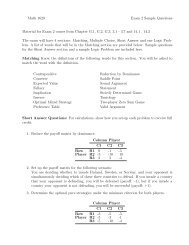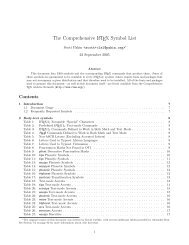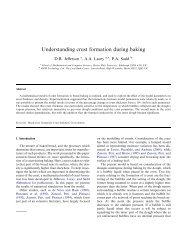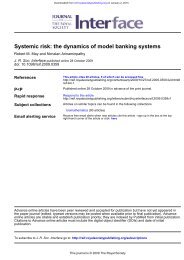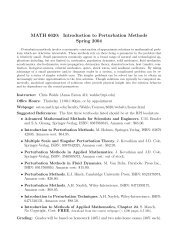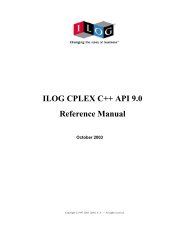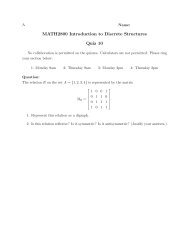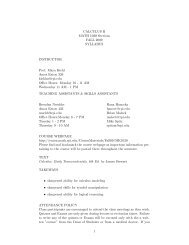Math 1020 Exam 3 - Possible Short Answer Questions Exam 2 ...
Math 1020 Exam 3 - Possible Short Answer Questions Exam 2 ...
Math 1020 Exam 3 - Possible Short Answer Questions Exam 2 ...
You also want an ePaper? Increase the reach of your titles
YUMPU automatically turns print PDFs into web optimized ePapers that Google loves.
<strong>Math</strong> <strong>1020</strong><strong>Exam</strong> 3 - <strong>Possible</strong> <strong>Short</strong> <strong>Answer</strong> <strong>Questions</strong><strong>Exam</strong> 2 covers sections 12.1, 12.2, 12.3, 12.4, 12.5, 12.6, 12.7, 13.1 and 16.6Any short answer question asked on <strong>Exam</strong> 3 will be modeled after ones given below.1. Given the points A(1, 1, 3), B(2, −3, 1), and C(0, 4, 4),(a) Determine if the three points A, B, and C lie on the same line.(b) Find a unit vector in the direction of AC ⃗ and a unit vector in the direction oppositeof AC. ⃗2. Forces with magnitudes of 500 pounds and 200 pounds act on a machine part at angles ofπ/6 and −π/4 with the x-axis. Find the resultant force vector.3. Given the vectors ⃗a =< 1, −4, ξ >, ⃗ b =< −3, 12, 6 >, and ⃗c = −4î + 3ĵ + 3ˆk:(a) Find ξ so that ⃗a is parallel to ⃗ b:(b) Find ξ so that ⃗a is orthogonal to ⃗c:(c) Evaluate −3⃗a + 2 ⃗ b4. Given the vectors ⃗u =< 4, 3, 0 > and ⃗v =< 2, −1, 2 >,(a) find the scalar projection of ⃗u onto ⃗v, comp ⃗v ⃗u:(b) find the vector projection of ⃗u onto ⃗v, proj ⃗v ⃗u:5. Find the cosine of the angle between the vectors ⃗r =< 3, 2, −1 > and ⃗s =< 1, 2, 2 >:6. Find the direction cosines for the vector ⃗r =< 3, 2, −1 >:7. An object is pulled 25 feet across a floor using a force of 40 lbs. Find the work done if thedirection of the force is 45 degrees above the horizontal.8. Find the area of the triangle defined by the three points P (1, 1, 3), Q(2, −3, 1) and R(0, 4, 4):9. Find the area of the parallelogram defined by the vectors ⃗r =< 3, 2, −1 > onto ⃗s =:10. Find two unit vectors that are orthogonal to both vectors given, ⃗u =< 2, 1, 3 >, and⃗v =< 3, −2, 0 >.11. A child applies breaks on a bicycle by applying downward force of 20 lbs on a pedal whenthe crank shaft is at a 30 degree angle with horizontal. Find torque at P if the crank is1/2 foot in length.12. Find the volume of the parallelipiped defined by the vectors ⃗u =< 4, 3, 0 >, ⃗v = and ⃗w =< 3, 2, 1 >:13. Write the equation in parametric and symmetric form for the line that passes through thepoint (1, 0, −4) and is parallel to ⃗u =< 4, 2, 3 > in the space below:
14. Find the vector equation of the line containing the points A(1, 1, 3) and B(2, −3, 1).15. Find the equation of the plane that contains the three points P (1, 1, 3), Q(2, −3, 1) andR(0, 4, 4):16. The two lines given below intersect when t = 1 and s = −1. Write down the point ofintersection and the cosine of the angle of intersection.Line 1: x = 1 − 2t y = −2 + t z = 2 + 4tLine 2: x = −3 − 2s y = 1 + 2s z = 3 − 3s17. Find the distance from the point Q(−6, 2, 1) to the plane 3x − 3y + z = 9. You mustinclude a sketch (not an exact graph) illustrating how you solved this problem. It shouldinclude the point Q, the plane and the distance you are trying to find.18. The lines x−2x−8= z − 4 and = y + 3 = z −32 −5equation of the plane that contains both lines.4= y+1intersect at the point (6,-4,5). Find an19. Find the point of intersection (if any) between the line x = y−22 −2−x + 3y + z = 15.= z−14and the plane20. Find the equation of the plane containing the point P (1, 3, 3) and perpendicular to theline x−4 = y+2 = z − 1.2 −421. Find the distance from the point P (4, 1, −2) to the line x = 2t + 2 y = 2t + 1 z = t − 3.22. Determine whether the two planes x − 3y + 6z = 4 and 5x + y − z = 4 are parallel,orthogonal, or neither. If they are neither, find the cosine of the angle between them.23. Given the surface 4x 2 − y 2 + 4z 2 = −16, Identify the traces in (and parallel) to eachcoordinate plane, i.e. x = k, y = k, and z = k. Identify the surface itself.24. Given the surface 4x 2 +z 2 −16x−16y = −16, Write the equation of the surface in standardform, identify the traces in (and parallel) to each coordinate plane, i.e. x = k, y = k, andz = k, AND identify the surface itself.25. Given the surface 4x 2 − y 2 + 4z 2 = −16, Transform the equation of the surface to acylindrical equation and a spherical equation.26. Transform the cylindrical equation sin θ = r cos 2 θ to a rectangular equation and identifythe surface.27. Transform the spherical equation 1 = 4 cos φ to a rectangular equation.28. Given the vector valued functions ⃗r(t) = 〈 √ t 2 − 25,tt 2 −1 , 2t2 〉(a) Where is the vector ⃗r(t) continuous?(b) Evaluate the lim t−>1 ⃗r(t).(c) Find ||⃗r(t)||29. Given the vectors ⃗u(t) = √ 4 − t î + sin 2t ĵ + ln t ˆk:(a) What is the domain of ⃗u(t)?
(b) Evaluate, if possible, ⃗u( π 6 ).30. Find the rectangular equation for the parametric surface given by ⃗r(u, v) = 2u cos (v)î +2u sin (v)ĵ + u 2ˆk. Identify the surface.31. Find the rectangular equation for the parametric surface ⃗r(u, v) = 〈1 + 2u, 3v, 2 + 4u + 2v〉and identify the surface.32. Find a vector valued function whose graph is the indicated surface. The cylinder x 2 +6y 2 =12.33. You may also be asked to match an equation with either a space curve from 13.1 problems19 - 24 or a surface from 16.6 problems 11 - 16.<strong>Exam</strong> # 3 Formulas⃗a ·⃗b = ‖⃗a‖‖ ⃗ b‖ cos θ‖⃗a × ⃗ b‖ = ‖⃗a‖‖ ⃗ b‖ sin θ


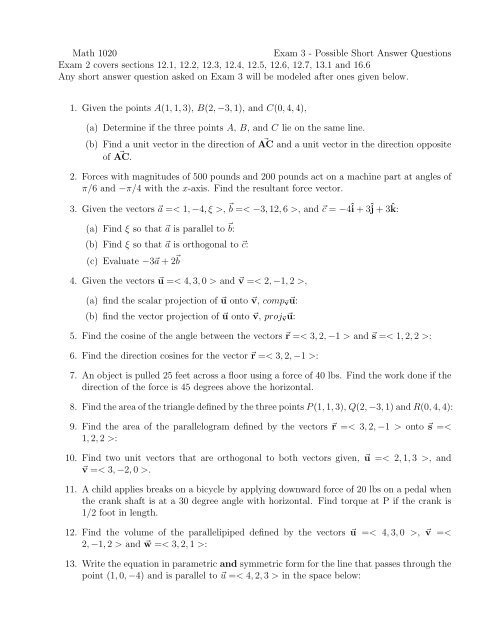
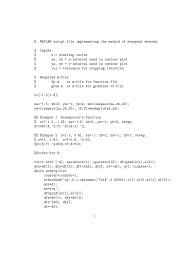

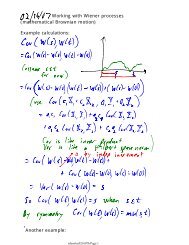
![MATH 1500 Sample Questions Exam 2 1. [3.7] A 10-ft plank is ...](https://img.yumpu.com/43861920/1/190x245/math-1500-sample-questions-exam-2-1-37-a-10-ft-plank-is-.jpg?quality=85)
